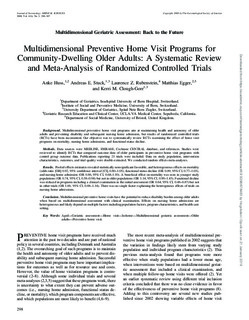| dc.identifier.citation | Huss, A., Stuck, A., Rubenstein, L., Egger, M. & Clough-Gorr, K. (2008) Multidimensional Preventive Home Visit Programs for Community-Dwelling Older Adults: A Systematic Review and Meta-Analysis of Randomized Controlled Trials. The Journals of Gerontology, 63a(3), 298-307. | nb_NO |
| dc.description.abstract | Background: Multidimensional preventive home visit programs aim at maintaining health and autonomy of older adults and preventing disability and subsequent nursing home admission, but results of randomized controlled trials (RCTs) have been inconsistent. Our objective was to systematically review RCTs examining the effect of home visit programs on mortality, nursing home admissions, and functional status decline. Methods: Data sources were MEDLINE, EMBASE, Cochrane CENTRAL database, and references. Studies were reviewed to identify RCTs that compared outcome data of older participants in preventive home visit programs with control group outcome data. Publications reporting 21 trials were included. Data on study population, intervention characteristics, outcomes, and trial quality were double-extracted. We conducted random effects meta-analyses. Results: Pooled effects estimates revealed statistically nonsignificant favorable, and heterogeneous effects on mortality (odds ratio [OR] 0.92, 95% confidence interval [CI], 0.80–1.05), functional status decline (OR 0.89, 95% CI, 0.77–1.03), and nursing home admission (OR 0.86, 95% CI, 0.68–1.10). A beneficial effect on mortality was seen in younger study populations (OR 0.74, 95% CI, 0.58–0.94) but not in older populations (OR 1.14, 95% CI, 0.90–1.43). Functional decline was reduced in programs including a clinical examination in the initial assessment (OR 0.64, 95% CI, 0.48–0.87) but not in other trials (OR 1.00, 95% CI, 0.88–1.14). There was no single factor explaining the heterogenous effects of trials on nursing home admissions. Conclusion: Multidimensional preventive home visits have the potential to reduce disability burden among older adults when based on multidimensional assessment with clinical examination. Effects on nursing home admissions are heterogeneous and likely depend on multiple factors including population factors, program characteristics, and health care setting. | nb_NO |
